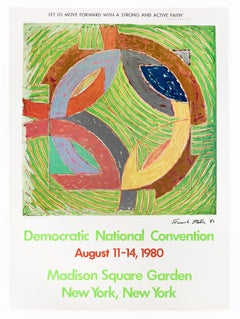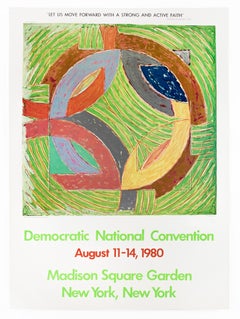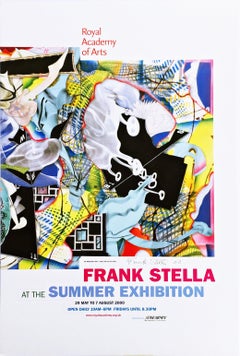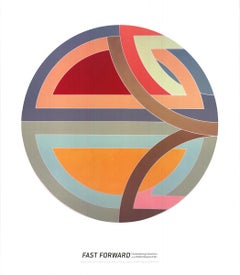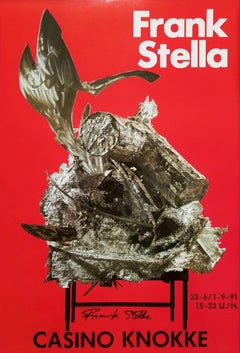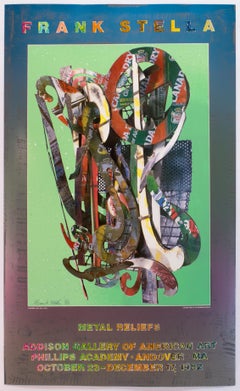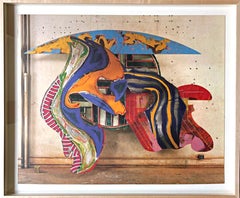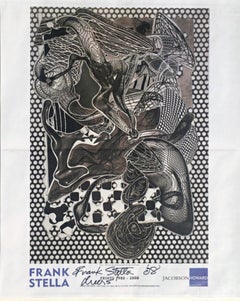Frank Stella Poster
1980s Pop Art Abstract Prints
Lithograph
1980s Pop Art Abstract Prints
Lithograph
Early 2000s Abstract Expressionist Abstract Prints
Lithograph, Offset
Late 20th Century Posters
Paper
Early 2000s Prints and Multiples
Offset
1990s Abstract Expressionist Abstract Prints
Lithograph, Offset, Permanent Marker
Late 20th Century Abstract Abstract Prints
Lithograph
1990s Abstract Expressionist Abstract Prints
Offset, Lithograph
Early 2000s Abstract Expressionist Abstract Prints
Lithograph, Offset
2010s Abstract Expressionist Abstract Prints
Lithograph, Offset
1990s Pop Art Abstract Prints
Lithograph, Offset
1980s Abstract Abstract Prints
Lithograph, Offset
1960s Pop Art Abstract Prints
Lithograph, Offset
1980s Pop Art Abstract Prints
Offset
Late 20th Century American Craftsman Posters
Paper
20th Century Prints and Multiples
Offset
20th Century Prints and Multiples
Offset
1960s Minimalist Abstract Prints
Offset
20th Century Prints and Multiples
Offset
1970s Abstract Abstract Prints
Lithograph
1980s Pop Art Abstract Prints
Lithograph
1980s Pop Art Abstract Prints
Lithograph
1980s Pop Art Abstract Prints
Lithograph
1980s Pop Art Abstract Prints
Lithograph
1980s Pop Art Abstract Prints
Offset
Vintage 1960s American Posters
Aluminum
Vintage 1970s American Modern Posters
Paper
1960s Minimalist Abstract Prints
Offset
Late 20th Century Abstract Abstract Prints
Lithograph
Late 20th Century Abstract Abstract Prints
Lithograph
1980s Pop Art Abstract Prints
Lithograph
1980s Pop Art Abstract Prints
Lithograph
1980s Pop Art Abstract Prints
Lithograph
1980s Pop Art Abstract Prints
Lithograph
1980s Pop Art Abstract Prints
Lithograph
1980s Pop Art Abstract Prints
Lithograph
1980s Pop Art Abstract Prints
Lithograph
1980s Pop Art Abstract Prints
Lithograph
1980s Pop Art Abstract Prints
Lithograph
1980s Pop Art Abstract Prints
Lithograph
1980s Pop Art Abstract Prints
Lithograph
1980s Pop Art Abstract Prints
Lithograph
20th Century Prints and Multiples
Offset
20th Century Prints and Multiples
Offset
20th Century Prints and Multiples
Offset
1980s Pop Art Abstract Prints
Lithograph
1980s Pop Art Abstract Prints
Lithograph
1980s Pop Art Abstract Prints
Lithograph
1960s Minimalist Abstract Prints
Offset
20th Century American Posters
Vintage 1970s American Contemporary Art
Paper
Vintage 1960s American Modern Posters
Frank Stella Poster For Sale on 1stDibs
How Much is a Frank Stella Poster?
Finding the Right Prints-works-on-paper for You
Decorating with fine art prints — whether they’re figurative prints, abstract prints or another variety — has always been a practical way of bringing a space to life as well as bringing works by an artist you love into your home.
Pursued in the 1960s and ’70s, largely by Pop artists drawn to its associations with mass production, advertising, packaging and seriality, as well as those challenging the primacy of the Abstract Expressionist brushstroke, printmaking was embraced in the 1980s by painters and conceptual artists ranging from David Salle and Elizabeth Murray to Adrian Piper and Sherrie Levine.
Printmaking is the transfer of an image from one surface to another. An artist takes a material like stone, metal, wood or wax, carves, incises, draws or otherwise marks it with an image, inks or paints it and then transfers the image to a piece of paper or other material.
Fine art prints are frequently confused with their more commercial counterparts. After all, our closest connection to the printed image is through mass-produced newspapers, magazines and books, and many people don’t realize that even though prints are editions, they start with an original image created by an artist with the intent of reproducing it in a small batch. Fine art prints are created in strictly limited editions — 20 or 30 or maybe 50 — and are always based on an image created specifically to be made into an edition.
Many people think of revered Dutch artist Rembrandt as a painter but may not know that he was a printmaker as well. His prints have been preserved in time along with the work of other celebrated printmakers such as Pablo Picasso, Salvador Dalí and Andy Warhol. These fine art prints are still highly sought after by collectors.
“It’s another tool in the artist’s toolbox, just like painting or sculpture or anything else that an artist uses in the service of mark making or expressing him- or herself,” says International Fine Print Dealers Association (IFPDA) vice president Betsy Senior, of New York’s Betsy Senior Fine Art, Inc.
Because artist’s editions tend to be more affordable and available than his or her unique works, they’re more accessible and can be a great opportunity to bring a variety of colors, textures and shapes into a space.
For tight corners, select small fine art prints as opposed to the oversized bold piece you’ll hang as a focal point in the dining area. But be careful not to choose something that is too big for your space. And feel free to lean into it if need be — not every work needs picture-hanging hooks. Leaning a larger fine art print against the wall behind a bookcase can add a stylish installation-type dynamic to your living room. (Read more about how to arrange wall art here.)
Find fine art prints for sale on 1stDibs today.
- 1stDibs ExpertAugust 29, 2024Frank Stella's philosophy, self-described as "what you see is what you see," reflects his belief that art shouldn't be representational and that its merit was in its actual form and not in any meaning that was assigned to it. He considered paintings on canvas to be objects in their own right, like sculptures, rather than representations. This led him to reject certain formal conventions, eschewing sketches and often using nontraditional materials, like house paint. Shop a range of Frank Stella art on 1stDibs.
- 1stDibs ExpertOctober 24, 2024Frank Stella's nationality was American. He was born in Malden, Massachusetts, in 1936. Although his parents were also born in the U.S., all four of his grandparents were natives of Italy who immigrated to the country. Stella attended Phillips Academy in Andover, earned a BA from Princeton University and, in 1958, relocated to New York City. He remained there for much of his life and died there in 2024. On 1stDibs, shop a collection of Frank Stella art.
- Who was Frank Stella's father?1 Answer1stDibs ExpertOctober 24, 2024Frank Stella's father was also named Frank. Although he worked as a gynecologist, the elder Frank Stella was an art lover and fostered his son's love of painting. Stella's mother, Constance, attended art school and was a landscape painter. On 1stDibs, explore a variety of Frank Stella art from some of the world's top galleries and dealers.
- 1stDibs ExpertAugust 29, 2024Frank Stella was famous for his work as an artist. He was one of the central figures in postwar American art. A proponent of Minimalism and non-representational abstraction, Stella was a painter, printmaker and sculptor. Some of his best-known works include Shoubeegi, Harran II and The Marriage of Reason and Squalor II. Find an assortment of Frank Stella art on 1stDibs.
- Why is Frank Stella famous?1 Answer1stDibs ExpertOctober 24, 2024Frank Stella is famous for his work as an artist. He was one of the central figures in postwar American art. A proponent of Minimalism and non-representational abstraction, Stella was a painter, printmaker and sculptor. His work is in the collections of numerous major museums around the world, including New York’s Museum of Modern Art and Metropolitan Museum of Art; the Menil Collection in Houston; the Hirshhorn Museum and Sculpture Garden in Washington, D.C. and the San Francisco Museum of Modern Art. He was awarded the National Medal of Arts by President Obama in 2009 and was given the Lifetime Achievement Award in Contemporary Sculpture by the International Sculpture Center in 2011. He died on May 4, 2024. Some of his best-known works include Harran II, Shoubeegi and “The Marriage of Reason and Squalor” series. On 1stDibs, shop a selection of Frank Stella art.
- Why is Frank Stella important?1 Answer1stDibs ExpertNovember 20, 2024Frank Stella is important because he was one of the central figures in postwar American art and influenced later artists as a proponent of minimalism and non-representational abstraction. Stella felt that paintings on canvas were objects in their own right, like sculptures. This led him to reject certain formal conventions, eschewing sketches and often using nontraditional materials, like house paint. His approach to art impacted the work of Clement Greenberg, Carl Andre, Kenneth Noland and many others. Find a collection of Frank Stella art on 1stDibs.
- 1stDibs ExpertAugust 29, 2024No, Frank Stella was not related to Joseph Stella. While it's possible that in-depth genealogical research may uncover a shared ancestor many generations ago, the two artists are not currently believed to be related. Joseph Stella was born in 1877 in Muro Lucano, Italy, while Frank Stella was born in 1936 in Malden, Massachusetts. On 1stDibs, shop a diverse assortment of Frank Stella and Joseph Stella art.
- 1stDibs ExpertAugust 29, 2024Frank Stella influenced art by encouraging the spread of Minimalism, an extreme form of abstraction that focuses on forms rather than meaning. Through his work, Stella challenged the notion that art must be a representation of something else. He believed that the art itself was the only true meaning of a piece. His philosophy influenced other artists and architects, such as Frank Gehry, Timothy App and Carl Andre. On 1stDibs, shop a range of Frank Stella art.
- 1stDibs ExpertOctober 24, 2024Frank Stella used a variety of techniques. The American artist eschewed sketches for his paintings and often used nontraditional materials, like house paint. In 1960, he began introducing color into his work and using unconventionally shaped canvases to complement his compositions. Following a solo show at the Museum of Modern Art in New York in 1970, Stella began working in three dimensions, adding relief elements to paintings, which could be considered wall-mounted sculptures. Stella’s 1970–73 “Polish Village” series was inspired by documentary photographs and architectural drawings of Polish synagogues that had been destroyed by the Nazis during World War II. The resulting works — composed primarily of paint and cloth on plywood — are more rugged and less polished than his previous series. Herman Melville's Moby-Dick was Stella's muse for a series of three-dimensional works he created in the 1980s in which waveforms, architectural elements and Platonic solids played a prominent role. During this period, Stella embraced a new, exuberant style exemplified in his piece La Scienza della Fiacca. In addition to paintings and sculptural works, the artist also produced prints using lithography, serigraphy, etching and offset lithography techniques. Explore an assortment of Frank Stella art on 1stDibs.
- 1stDibs ExpertOctober 24, 2024Frank Stella went to college at Princeton University, earning a bachelor of arts from the institution. While there, he studied art and color theory with Josef Albers and Hans Hofmann. Stella frequented New York galleries as a student and was intrigued by the work of Jackson Pollock and Franz Kline, both of whom were at the height of their creative powers in the late 1950s. After moving to New York in 1958, Stella gravitated toward the geometric abstraction and restrained painting style of Barnett Newman and Jasper Johns. On 1stDibs, shop a collection of Frank Stella art.
- 1stDibs ExpertOctober 15, 2024You can see Frank Stella art at a number of museums. Some institutions in the U.S. that have Stella pieces in their permanent collections include the San Francisco Museum of Modern Art in San Francisco, California; the Museum of Modern Art (MoMA) in New York City, New York and the Chrysler Museum of Art in Norfolk, Virginia. In addition, museums may host temporary exhibitions of the artist's work. On 1stDibs, find a selection of Frank Stella art.
- 1stDibs ExpertNovember 20, 2024Here are three interesting facts about Frank Stella. First, Stella considered paintings on canvas as objects in their own right, like sculptures, rather than representations. This led him to reject certain formal conventions, eschewing sketches and often using nontraditional materials, like house paint. Secondly, Stella created a series of works named after the ancient cities whose circular plans Stella had noticed while traveling in the Middle East during the 1960s. Called the “Protractor” series, these works usually involved several canvases set flush against one another so that the geometric figures in each section came together in a larger, more complex whole. In addition, Stella was awarded the National Medal of Arts by President Obama in 2009 and was given the Lifetime Achievement Award in Contemporary Sculpture by the International Sculpture Center in 2011. On 1stDibs, shop a wide variety of Frank Stella art.
- 1stDibs ExpertAugust 29, 2024Frank Stella started making freestanding sculptures in the 1990s. In 1997, the artist oversaw the creation of the Stella Project, a 5,000-square-foot work inside the Moores Opera House at the University of Houston, and a large free-standing sculpture by Stella produced during this period stands outside the National Gallery of Art in Washington, D.C. However, Stella's work began to move toward sculpture much earlier. Following a solo exhibition at the Museum of Modern Art in 1970, Stella began working in three dimensions, adding relief elements to paintings, which could almost be considered wall-mounted sculptures. On 1stDibs, shop a variety of Frank Stella art.
- 1stDibs ExpertAugust 29, 2024The art style Frank Stella is known for is Minimalism, a fully nonrepresentational form of abstraction. Stella considered paintings on canvas as objects in their own right, like sculptures, rather than representations. This led him to reject certain formal conventions, eschewing sketches and often using nontraditional materials, like house paint. Find a variety of Frank Stella art on 1stDibs.
- 1stDibs ExpertOctober 24, 2024Frank Stella made Harran II because of his interest in moving his work away from representation toward minimalist abstractions. He believed paintings on canvas were objects in their own right, like sculptures, rather than symbols for something else. Harran II was a part of Stella's Protractor series, characterized by colorful circles and arcs. Named after the ancient cities whose circular plans Stella had noticed while traveling in the Middle East during the 1960s, these works usually comprise several canvases set flush against one another so that the geometric figures in each section come together in a larger, more complex whole. In the case of Harran II, the name is a nod to a city in Turkey where Stella was inspired by intricate, colorful tile mosaics. Find a variety of Frank Stella art on 1stDibs.
- 1stDibs ExpertMay 7, 2024Frank Stella (1936–2024) made paintings, prints and sculptures. One of the central figures in postwar American art, Stella was a proponent of minimalism and non-representational abstraction. His famous works include Sinjerli Variation IV, Harran II and his “Eccentric Polygon” series.
Stella burst onto the scene barely out of college with his “Black Paintings,” sober geometric studies composed of wide black stripes separated by chalky white lines. These won him inclusion in “16 Americans,” the famed 1959–60 group show at New York’s Museum of Modern Art. He stayed at the forefront of art, working with famed gallerist Leo Castelli, relentlessly pursuing geometric form and never repeating himself.
Find a collection of Frank Stella art for sale on 1stDibs. - 1stDibs ExpertOctober 24, 2024Frank Stella actually used more than one element of art. A proponent of Minimalism and non-representational abstraction, Stella was a painter, printmaker and sculptor. Considering paintings on canvas as objects in their own right, like sculptures, rather than representations, he rejected certain formal conventions, eschewing sketches and often using nontraditional materials, like house paint. Over the course of his career, his pieces became more and more three-dimensional, straddling the line between painting and sculpture. In the mid-1960s, Stella started exploring printmaking, initially working with Kenneth Tyler of Gemini G.E.L. and later installing printing equipment in his own studio. On 1stDibs, shop a diverse assortment of Frank Stella art.
- 1stDibs ExpertAugust 29, 2024To create his lithographs, Frank Stella used a variety of materials. Many of his prints began with collages made of enamel paint, etched magnesium, aluminum and fiberglass. Then, he would transfer the image to a lithograph stone and apply it to paper. For many lithographs, he also employed screen printing techniques to create a layered effect. Shop a collection of Frank Stella art on 1stDibs.
Read More
Joan Mitchell’s Rare, Late-Career Diptych Buzzes with Life
Beneath the inky blackness, the painter’s irrepressible energy electrifies this pair of intaglio prints.
The 1stDibs Guide to Types of Abstract Art
Get to know the key movements and artists who have influenced visual culture for more than a century.
Romare Bearden’s Humanity Infuses His Bright, Bold Art
Through collage, painting and printmaking, the artist foregrounded Black life in America in revolutionary new ways.
Andy Warhol and Suzie Frankfurt’s ‘Wild Raspberries’ Cookbook Is an Artful, Fanciful Delight
This set of recipes and original prints might not make you a better chef. But it will make you smile.
Art Brings the Drama in These Intriguing 1stDibs 50 Spaces
The world’s top designers explain how they display art to elicit the natural (and supernatural) energy of home interiors.
Welcome (Back) to the Wild, Wonderful World of Walasse Ting
Americans are rediscovering the globe-trotting painter and poet, who was connected to all sorts of art movements across a long and varied career.
Shapero Modern’s Director Tells Us All about 20th-Century Prints
Tabitha Philpott-Kent knows a lot of art multiples. Here, the London gallery director talks about what makes printmaking so fabulous.
Yoshitomo Nara Puts a Punk Rock Twist on the Traditional Prints of His Ancestors
The forever-rebellious Japanese artist craftily defaces famous Edo Period woodblock prints with “In the Floating World.”
